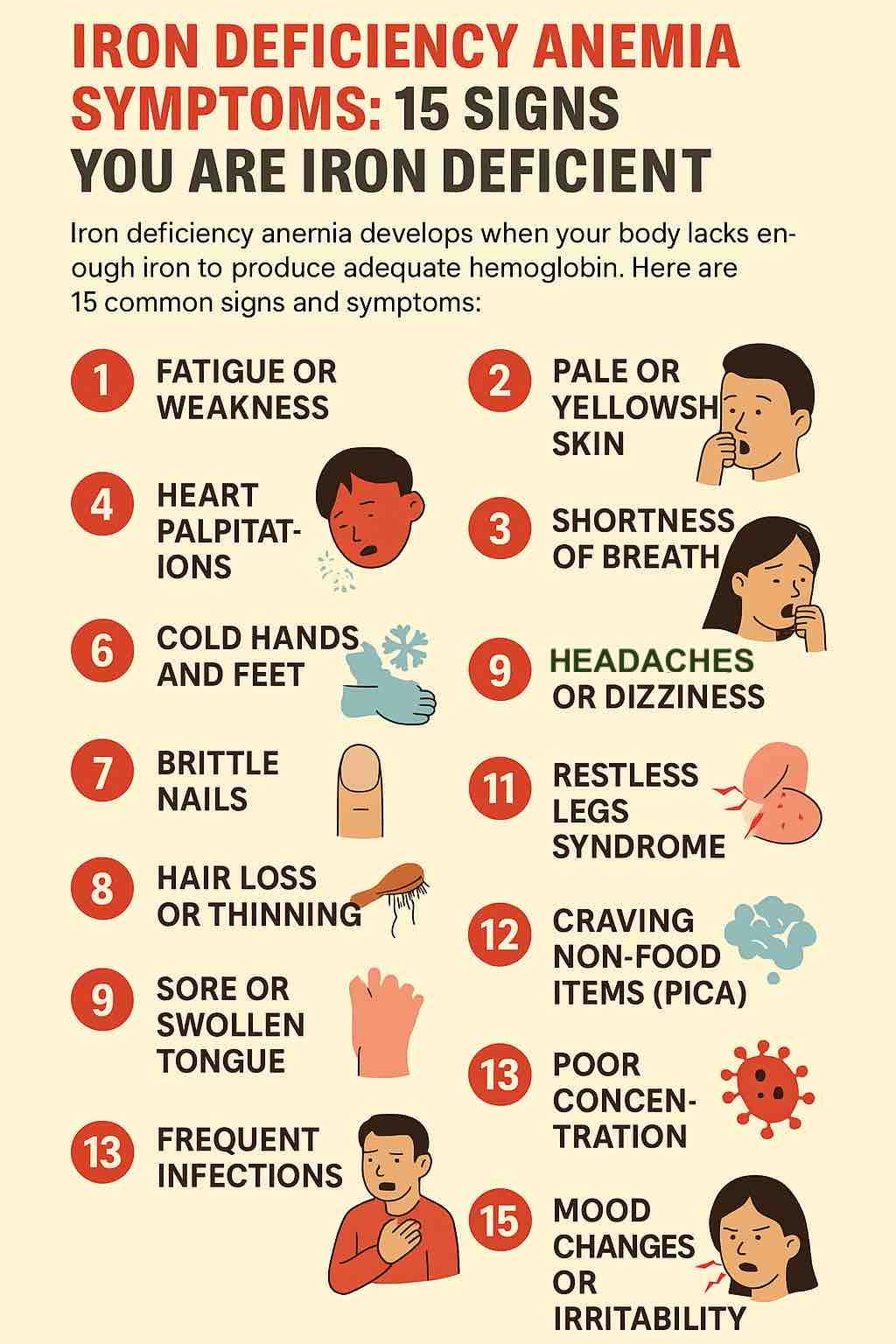
Iron — a mineral so small, yet so mighty. It fuels your cells with oxygen, supports energy levels, boosts immunity, sharpens your mind, and even affects your mood. But when your body runs low on this essential nutrient, the symptoms can sneak up on you like a slow fog — subtle at first, then overwhelming.
Welcome to a comprehensive guide on Iron Deficiency Anemia — the most common nutritional deficiency worldwide — affecting more than 1.2 billion people. Whether you’re constantly tired, battling hair loss, or struggling with concentration, the root of the problem might just be a simple mineral you’re missing.
Let’s uncover the 15 key signs you might be iron deficient, how this condition differs in men and women, and what you can do to correct it before it takes a toll on your health.
🩸 What Is Iron Deficiency Anemia?
Iron Deficiency Anemia (IDA) occurs when your body doesn’t have enough iron to produce adequate hemoglobin — the oxygen-carrying part of red blood cells.
Without enough iron, your body is literally starved of oxygen. The result? A cascade of symptoms that affect everything from your energy to your brain function.
Primary Causes Include:
- Poor dietary intake (common in vegetarians/vegans)
- Heavy menstrual bleeding
- Gastrointestinal issues (ulcers, IBD, celiac disease)
- Pregnancy
- Chronic blood loss (e.g. internal bleeding, frequent blood donation)
🚨 15 Signs You Are Iron Deficient
Here are the most common and clinically recognized symptoms — from mild to severe:
1. Fatigue That Doesn’t Go Away
Even after a full night’s sleep, you feel drained. That’s because your cells aren’t getting enough oxygen to fuel energy.
2. Pale or Yellowish Skin
Your skin, gums, and inner eyelids may appear unusually pale — a visual clue of reduced hemoglobin levels.
3. Shortness of Breath
Climbing stairs? Walking to the store? You find yourself winded much faster than usual.
4. Heart Palpitations
Low iron can cause your heart to work harder, leading to irregular or rapid heartbeats, even at rest.
5. Cold Hands and Feet
A lack of oxygen circulation may leave your extremities icy cold — even when it’s warm.
6. Frequent Headaches or Dizziness
Low hemoglobin levels can reduce oxygen flow to the brain, triggering pressure headaches or lightheadedness.
7. Brittle or Spoon-Shaped Nails
Nails that break easily, peel, or curve upward (spoon nails) may indicate chronic iron deficiency.
8. Hair Loss or Thinning
Thinning hair and increased shedding are common when iron stores are depleted.
9. Sore or Swollen Tongue (Glossitis)
Your tongue may become inflamed, smooth, tender, and even appear shiny.
10. Restless Legs Syndrome
An irresistible urge to move your legs, especially at night, has been linked to low iron levels in the brain.
11. Craving Non-Food Items (Pica)
Do you crave ice, chalk, clay, or even dirt? This bizarre symptom is a hallmark of advanced iron deficiency.
12. Poor Concentration (Brain Fog)
Struggling to focus or remember things? Low oxygen supply to the brain can dull cognitive function.
13. Weakened Immunity
Frequent infections, slow wound healing, or persistent colds? Iron is essential for a strong immune response.
14. Chest Pain or Tightness
In severe cases, low oxygen delivery to the heart may cause pain, especially during exertion.
15. Mood Changes — Depression or Irritability
Iron plays a role in neurotransmitter production (like dopamine), and deficiency can trigger mood instability.
👨⚕️ Does Iron Deficiency Affect Men Differently?
While more common in women (due to menstruation and pregnancy), men are not immune to iron deficiency. In fact, symptoms in men often go unrecognized or misdiagnosed because they aren’t routinely screened.
Top Causes in Men:
- Poor diet
- Hidden GI bleeding (from ulcers, colon polyps, etc.)
- Long-distance running (foot-strike hemolysis)
- Regular blood donation
Unique Red Flags in Men:
- Sudden fatigue or drop in exercise performance
- Decreased libido or testosterone levels
- Muscle weakness
- Brain fog or irritability
If you’re a man experiencing these symptoms — especially if they appear suddenly — don’t ignore them.
🧪 How Is Iron Deficiency Diagnosed?
Your doctor will likely order:
- Complete Blood Count (CBC): Measures hemoglobin and hematocrit.
- Serum Ferritin: A marker of stored iron. Below 45 ng/mL indicates deficiency, even without anemia.
- Serum Iron, TIBC, and Transferrin Saturation: Give a full picture of iron metabolism.
🔍 Pro Tip: Always ask for ferritin if you suspect low iron — a normal hemoglobin level alone doesn’t rule out early deficiency.
🥦 Best Ways to Boost Your Iron Levels
1. Iron-Rich Foods:
- Red meat (beef, lamb, liver)
- Poultry and fish
- Dark leafy greens (spinach, kale)
- Lentils, chickpeas, beans
- Tofu and tempeh
- Fortified cereals and grains
- Pumpkin seeds, quinoa
2. Enhance Absorption:
- Pair iron-rich foods with vitamin C (like citrus, bell peppers).
- Avoid tea, coffee, and calcium supplements around iron-rich meals — they block absorption.
3. Consider Iron Supplements:
- Ferrous sulfate: Affordable and widely available.
- Iron bisglycinate: Gentler on the stomach and equally effective.
- Take supplements on an empty stomach or with a small dose of vitamin C.
4. IV Iron:
Recommended for those who can’t tolerate oral supplements, have absorption issues, or need rapid replenishment.
🧾 Final Thoughts
Iron deficiency doesn’t always roar — it whispers through fatigue, brain fog, and subtle physical changes. But left unchecked, it can become debilitating.
The good news? It’s easily diagnosed, highly treatable, and completely reversible with the right strategy.
If you’ve recognized yourself in the signs above, it’s time to take action. Your body — and your brain — will thank you.
📌 Stay Informed. Stay Empowered.
Feeling tired shouldn’t be your normal. Don’t guess — get tested, eat smart, and supplement wisely.
➡️ For more wellness guides and nutrition-backed advice, visit MasalaMonk.com — where we break down ancient wisdom and modern science for better living.
🧠 Frequently Asked Questions (FAQs)
1. What is the most common symptom of iron deficiency?
Fatigue is the most reported symptom. Since iron helps transport oxygen in the blood, low levels mean your body and brain receive less oxygen, leading to persistent tiredness.
2. Can you be iron deficient without being anemic?
Yes. This is known as iron deficiency without anemia (IDWA). You may have low ferritin (iron stores) but normal hemoglobin. Symptoms can still occur, such as fatigue, hair loss, or brain fog.
3. How is iron deficiency anemia diagnosed?
A combination of tests is used:
- CBC (checks hemoglobin and red blood cell count)
- Serum ferritin (iron storage)
- TIBC and transferrin saturation (iron transport and availability)
4. What are unusual signs of iron deficiency?
- Craving non-food items like ice (pica)
- Restless legs syndrome
- Beeturia (reddish urine after eating beets)
These symptoms are increasingly recognized as red flags.
5. Is iron deficiency common in men?
While less common than in women, men can still become iron deficient, often due to hidden gastrointestinal bleeding, poor diet, or frequent blood donation.
6. How long does it take to correct iron deficiency?
Most people start to feel better within 2 to 4 weeks of treatment. Full iron restoration can take 3 to 6 months or longer, depending on severity and cause.
7. What foods should I avoid when trying to absorb iron?
Avoid consuming the following around iron-rich meals:
- Tea or coffee (tannins)
- Calcium-rich foods or supplements
- High-fiber cereals (phytates)
These can inhibit iron absorption.
8. Can iron supplements cause side effects?
Yes, especially ferrous sulfate, which may cause constipation, nausea, or dark stools. Gentler alternatives like iron bisglycinate are easier on the gut.
9. What’s the best time to take iron supplements?
Take them on an empty stomach (ideally 1 hour before meals) with Vitamin C to boost absorption. Avoid taking with milk, tea, or calcium.
10. When should I see a doctor about low iron symptoms?
If you experience persistent fatigue, paleness, shortness of breath, or any of the listed signs, consult a doctor. A simple blood test can confirm iron deficiency and help determine the best course of action.













